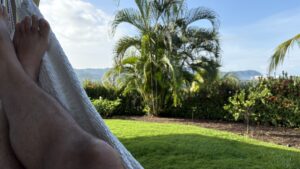This column originally appeared August 23, 1996.
World travelers, when their trekking days are ending, often sit and debate their favorite vistas. We too get out the picture albums once in awhile and argue the preferences they offer.
Taken together, they represent the best reason to travel: seeing something different when you open your eyes each morning.
The Mosel River valley in southwestern Germany is a favorite. We visited first in 1990, by chance arriving during New Wine Festival, when the sweet young wine that had eluded the bottlers was served to tents of happy revelers, very like the familiar scenes of Oktoberfest’s beer celebration. Strangers became instant friends linking arms and rocking to rollicking oom-pah-pah folk tunes.
What we loved best, however, was the great river itself winding sinuously between vine-covered banks. Banks so steep, workers actually use small cog-trains and pulley systems to lower precious cargo to the trucks that take it to the wine-press. Broad walkways stretch for miles along the river, on one or both sides, great for rambling and even better for riding bicycles from village to village.
We tried, really we tried, not to go back to places we had already visited, but we couldn’t help ourselves when we found ourselves near Zell, a village now linking both sides of the river, thanks to a graceful new footbridge. We stopped at Frau Haas’ “Zimmer frei” sign, and though the price was over-budget, fell in love with the incomparable views.
An amsel sang from the tip of the nearest fir tree — this black relative of the American robin is the last to hush at night and the first to sing in the morning.
But we remember best the sight of barges negotiating curves and currents, the water glistening as evening deepened, the rows of young vines pruned and tied to supports in the Mosel manner.
A month later we were in a dingy little room in a dingy little hotel across the street from Notre Dame Cathedral in Bayeux, Normandie. We came to this west-coastal section of France mostly because Dave had always wanted to visit World War II sites in the area. I promptly embraced the ancient town and its historic tapestry.
More than 800 meters long — that’s 2,623 feet — this priceless piece of craftsmanship tells in hand-worked pictures the story of William the Conqueror’s route to the British throne. Housed in a museum of its own near the cathedral, visible to tourists while safe behind glass, the tapestry is exactly where it was intended to be: in Bayeux, France, in the custody of the cathedral the Conqueror ordered built to reflect his own glory.
The cathedral is probably the most beautiful we’ve seen. The two oldest towers are Romanesque, square and functional. But the Gothic lantern tower over the transept — delicate, almost lacy. Never mind that it (like everything else in Europe that year) is swathed with scaffolding.
On our first night in Bayeux, I glanced out the window and saw a vision: the cathedral’s spires glowing with a pale gold light, the uppermost part of the tallest appearing to be lit internally in silvery blue. The sky was darkening, from grey-blue to deep blue and finally to black, and the unearthly image almost shimmered.
I could hardly tear my eyes off it. I pulled back the drapes and tied the sheers up out of the way so I could see it from my pillow until I fell asleep.
In the northernmost mountains of Italy, the Sud-Tirol, we found Kastelroth, and a room-with-a-view. It required a climb to the third floor, but the view was stupendous.
The tallest local mountain, Schlernberg, filled the window. Clouds wreathed the top most of the time we were there, changing constantly. I don’t believe we ever saw it unveiled.
Level with our window, in the very top of a tall fir, two magpies were building a nest. Looking left, we could see the upper peaks of other mountains, and below, the village of St. Valentin with its tiny church of the same name. The fields were brilliant green and crisscrossed with walking paths, Christ Crucified celebrated in a tiny shrine at each intersection.
The vista in England’s Cornwall was different from these, although it also changed from day to day, from hour to hour. To the left: St. Michael’s Mount rises from Mount’s Bay, eerily disappearing and reappearing in fog. A causeway stretches to it, visible only at very low tides.
To the right: Penzance Harbor, a few dozen sailboats tied there, sagging to one side when the tide goes out. The blue and white ferry to the Isles of Scilly is moored at the harbor’s entrance much of the time.
Across the street at our feet: railroad tracks. Just beyond, a shallow stony beach where the in-coming tide breaks. Then the curving bay, the wheeling, screaming gulls, and a couple of sailboats and fishing boats plying the waters in almost any weather.
Once, the roar of the incoming tide woke me early, but the trains, from two-car lengths to the 8-car Intercity, came and went almost silently day and night, at times empty, at others, full of school kids, tourists, commuters.
Always, always, something to watch, if only the weather, the moving water, light and clouds. A river, a cathedral, a mountain, a bay — a pleasant dilemma, to choose your views! [Sallie Satterthwaite of Peachtree City has been writing for The Citizen since our first issue Feb. 10, 1993. Before that she had served as a city councilwoman and as a volunteer emergency medical technician. She is the only columnist we know who has a fire station named for her. Her email is SallieS@Juno.com.]













Leave a Comment
You must be logged in to post a comment.